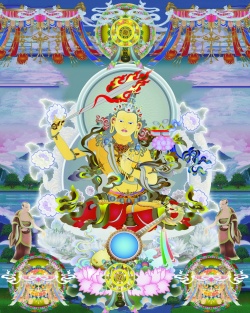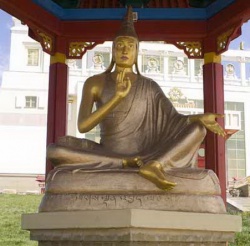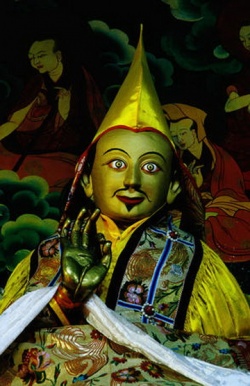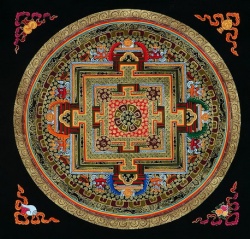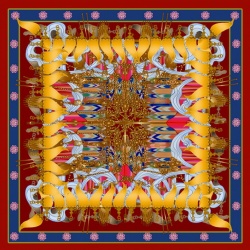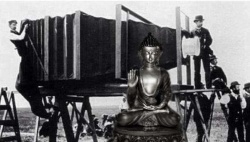Difference between revisions of "Nirvana Sutra: Chapter Thirteen: On Letters"
| Line 141: | Line 141: | ||
[[Category:Nirvana Sutra - English]] | [[Category:Nirvana Sutra - English]] | ||
| − | {{DEFAULTSORT:Nirvana Sutra: Chapter b3}} | + | {{DEFAULTSORT:Nirvana Sutra: Chapter b3}}{{Nirvana Sutra-English}} |
Latest revision as of 17:28, 26 December 2013
Mahayana Mahaparinirvana Sutra
Translated by KOSHO YAMAMOTO
FROM Dharmakshema's Chinese version
The World's genuinely first-ever web edition of this complete scripture
(This "Yamamoto/page edition" is Copyright of Dr. Tony Page, 2004 )
The Complete Kosho Yamamoto English Translation of the "Nirvana Sutra", edited and revised by Dr. Tony Page, typographically improved by Jay and Gabriele Mazo
Chapter Thirteen: On Letters
“The Buddha said to Bodhisattva Kasyapa: "All such different opinions, fortune-telling, language, and letters are what the Buddha spoke and not what was said by tirthikas." Bodhisattva Kasyapa said to the Buddha: "O World-Honoured One! How do you, the Tathagata, tell (of) the root concept of letters?" The Buddha said: "O good man! First, the half-letter (i.e. the phonic alphabet of Sanskrit) is taught and is made the root-concept. This holds good for all written things, fortune-telling, sentences, all elements and realities. Common mortals learn the foundation of letters. Later, they come to know what is right and what is not."
Bodhisattva Kasyapa said to the Buddha: "O World-Honoured One! What is the meaning of the letter?" "O good man! It stands on fourteen phonic bases, which constitute the meanings. The so-called letter is Nirvana. Being Eternal, it does not flow away. What does not flow away knows no end. What knows no end is the Adamantine Body of the Tathagata. These fourteen constitute the foundation of letters.
"A" is so called because it does not get destroyed. What is indestructible is the Three Treasures. For example, this is like the diamond. It is also so called because it does not flow away. What does not flow away is the Tathagata. In the nine holes (i.e. outlets of the body: two eyes, two ears, two nostrils, mouth, two outlets for excretion) of the Tathagata, there is nothing that flows away. So, it is the unflowing (“anasrava” - non-defilement). And there are nine holes. Hence, it is "non-flowing". Non-flowing is the Eternal; the Eternal is the Tathagata. The Tathagata is not that which has been created. Hence, he is non-flowing. Also, "a" is virtue. Virtue is the Three Treasures. For this reason, we say "a".
"Next, "ã" stands for "ãcãrya". What does "ãcãrya" mean? In worldly life, we can call him a "holy person". Why do we say "holy person"? "Holy" means "non-attached". It means "of little desire" and "feeling contented". Also, it is called "pure". It thoroughly passes beings across the great sea of the three worlds of birth and death. That is why we say "holy".
"Also, "ã" means "institution" (implementation), which is to act in accordance with the pure precepts and observe deportment.
"Also, "ã" means to depend upon a holy person. This is to learn his comings and goings and all that he does. The three holy ones are given offerings, respected and worshipped. One faithfully serves one's parents and studies the Mahayana. Good men and women uphold the prohibitions. And all Bodhisattvas are called "holy ones". "á" also means "order". It says: "Come and do this; you should not do it like that." So do things go. One who checks and suppresses non-deportment is a holy one. That is why we say "ã".
"I" is the Buddhist teaching. Pure action is extensive, pure and untainted. It is, for example, like the full moon. "Do thus, not like that; this is right, that is not right; this is a sermon of the Buddha, and this is what Mara says. "Hence, we say "i".
"We say "ã". The meaning of the Buddhist teaching is wonderful and profound. It is as when we call the laws (dharmas) of Mahesvara and Brahma unmolested (unlimited). Well upheld, it (Buddhist teaching) is the protection of Dharma.
"Also, unmolestedness (unlimitedness, unrestrictedness) is called the four protections of the world. As these four are unmolested, one well takes in and protects the Great Nirvana Sutra, and one unmolestedly expounds and disseminates (it).
"Also, next, "ã" stands for the unmolested (unhindered, unstinting) dissemination of Dharma to beings.
"Also, next, "ã"is the unmolested (unconstrained). It asks and says what is right. This is nothing other than the learning of the vaipulya sutras.
"Also, next, "ã" stands for the crushing out of jealousy. When the barnyard grass has been thoroughly weeded out, everything changes into what is auspicious. So we say "ã".
"U" stands for Great Nirvana, the Highest, the most superb, the pinnacle of pinnacles of all sutras.
"Also, next, "u" stands for the nature of the Tathagata, which no sravakas and pratyekabuddhas hear about. This is like Uttarakuru being the best of all places. If any Bodhisattva indeed hears this sutra, he is the highest and most superb. Hence, we say "u".
"â" is, for example, like cow's milk, which is the best of all tastes. The nature of the Tathagata is also like that. Of all sutras, this is the holiest and best. Anyone who slanders (it) is none but a cow.
"Also, next, "ä" is called "not-wise". A person thoroughly slanders the delicate and hidden storehouse of the Tathagata. Know that this person is most to be pitied. Parting from the hidden storehouse of the Tathagata, he speaks about no-Self. Henc, we say "ä".
"E" is the “Dharmata” and Nirvana of all Buddhas. Hence, we say "e".
"Ai" means "Tathagata".
"Also, "ai" refers to the goings and comings, bendings and stretchings, and the deeds of the Tathagata, by which not one amongst all beings is (not) benefited. Hence, "ai".
"O" stands for illusion; illusion is "asrava" (defilement). The Tathagata is eternally free from illusion. Hence, "o".
"Au" means Mahayana. It stands for the utmost of all the fourteen sounds. The case of the Mahayana sutras is also like this. They are the ultimate of all sutras and shastras. Hence, "au".
"Am" makes away with all impurities. In the Buddhist teachings, all gold, silver and treasures are abandoned. Hence, "am".
"Ah" means "superb vehicle". Why? This Mahayana sutra, this Great Nirvana Sutra, is the most superlative of all sutras. Hence, "ah".
"Ka" calls forth great compassion towards all beings. The thought of a son arises, as towards Rahula. It means "wonderfully good". Hence, "ka".
"Kha" stands for "non-good friend". "Non-good friend" means mixed and defiled. He does not believe in the hidden store of the Tathagata. Hence, "kha".
"Ga" means "store". "Store" means the undisclosed store of the Tathagata. All beings have the Buddha-Nature. Hence, "ga".
"Gha" is the eternal sound of the Tathagata. What is the eternal sound of the Tathagata? The so-called Tathagata is eternal and does not suffer change. Hence, "gha".
"Na" represents the breaking (destructible, impermanent) characterstics of all beings. Hence, "na".
"Ca" means "to practise". As it subdues all beings, we say "practise".
"Cha" means "Tathagata", who houses (shades, protects) all beings, as in the case of a great parasol. Hence, "cha".
"Ja" means "right (true) emancipation". There arises (in this) no ageing. Hence, "ja".
"Jha" stands for the great proliferation of defilements, as in the case of a great forest. Hence, "jha".
"Na" means "Wisdom". It means true “Dharmata”. Hence, "na".
"Ta" signifies speech delivered about dharmas in Jambudvipa, showing a half-body, as in the case of the half-moon. Hence, "ta".
"Tha" represents the perfection of the Dharma-Body, as in the case of the full moon. Hence, "tha".
"Da" represents an ignorant bhiksu who does not know the Eternal and the non-Eternal, as in the case of a child. Hence, "da".
"Dha" represents a person who feels no obligation towards his teacher, as in the case of a ram. Hence, "dha".
"Na" represents lack of knowledge of the meaning of what is holy, as in the case of a tirthika. Hence, "na".
"Ta" represents the Tathagata, who says to all bhiksus: "Come away from fright and fear. I shall now deliver sermons on Wonderful Dharma." Hence, "ta".
"Tha" means "ignorance". Beings repeat birth and death and bind themselves, as in the case of a silkworm or dung-beetle. Hence, "tha".
"Da" means "great giving". This is the so-called Mahayana. Hence, "da".
"Dha" praises "virtue". It is as in the case of the Three Treasures, which are like Mount Sumeru, soaring up, grand, extensive and, yet, not inclining to one side. Hence, "dha".
"Na" alludes to the Three Treasures, which stand peacefully rooted, not inclining to one side or moving, like the threshold of a gate. Hence, "na".
"Pa" means "inverted". If a person says that the Three Treasures expire, this shows that that person himself entertains doubt. Hence, "pa".
"Pha" refers to the ill-fortune of the world. If a person says that when ill-fortune arises in the world, the Three Treasures also expire, this indicates that that person is ignorant, that he has no knowledge, and that he acts against the holy will. Hence, "pha".
"Ba" refers to the ten powers of the Buddha. Hence, "ba".
"Bha" refers to the shouldering of what is heavy. It can stand bearing the heaviness of Wonderful Dharma. Know that such a person is a great Bodhisattva. Hence, "bha".
"Ma" refers to all Bodhisattvas who strictly uphold all the institutions (rules). This is so-called Mahayana Mahaparinirvana. Hence, "ma".
"Ya" alludes to all those Bodhisattvas who, for the benefit of beings, preach the Mahayana doctrine in all places. Hence, "ya".
"Ra" crushes out greed, anger and ignorance, and disseminates Wonderful Dharma. Hence, "ra".
"La" relates to the sravaka vehicle, which moves, changes, and has no place to live in (i.e. no permanent abode). Mahayana is safe and firm and there is no inclining or moving (with it). Abandoning the sravaka vehicle, one makes effort and practises the unsurpassed Mahayana. Hence, "la".
"Va" means that the World-Honoured One is he who showers down upon all beings the great rain of the Dharma. He is, as it were, a so-called fortune-telling sutra. Hence, "va".
"â" means to part from the three arrows (the three barbs of greed, malevolence and ignorance). Hence, "ä".
"Sa" means "perfection". If one truly hears this Great Nirvana Sutra, one already hears and upholds all about Mahayana sutras. Hence, "sa".
"Sa" means that Wonderful Dharma is expounded to all beings, so that people feel blessed. Hence, "sa".
"Ha" bespeaks the mind's state of gladness. How wonderful is it that the World-Honoured One departs from all actions; strange is it that the Tathagata enters Parinirvana. Hence, "ha".
"Lham" signifies "Mara". Innumerable Maras are unable to destroy the hidden storehouse of the Tathagata. Hence, "lham".
"Also, further, 'lham' signifies that one lives in accordance with what obtains in the world and parents, wife and children. Hence 'lham'.
"The four letters, r,r, l, l, have four meanings. These are Buddha, Dharma, Sangha, and Abhidharma. Abhidharma relates to what obtains in the world. It shows that Devadatta destroys the Sangha. He transforms himself into various forms, faces and concrete forms. The case is like this. All this is to establish vinaya. The wise should clearly see through this and not entertain any fear. This is following what obtains in the world. Hence, r,r,l,l.
"The inhalation of breath is the sound which one gets when the tongue accords with the nose. We gain the meaning by the long, short, or the one that supercedes the sound. All differ according to the actions of tongue and teeth.
"All such meanings of the letters well enable beings to purify their verbal actions. The Buddha-Nature of beings does not first become pure when assisted by letters. Why not? Because that nature is originally pure. Also, while co-existing with the five skandhas, the 18 realms and the 12 spheres (of the senses), the Buddha-Nature is not one with the five skandhas, the 18 realms and the 12 spheres. Because of this, all beings should take refuge in the Bodhisattvas and others. Because of the (existence of the) Buddha-Nature (within them), beings are viewed with equal (non-discriminating) eyes, and there is no difference. Hence, the half-letters form the basis of all sutras, all written material, and sentences.
"Also, the meaning of the half-letters refers to the root of all defilements. So they are called half-letters. The full letters are the root of all good dharmas and speech. For example, those of the world who do evil are called half-letters, and those who do good full-letters. Thus, all sutras and the Abhidharmas are based upon the half-letters. People may say that the Tathagata and true emancipation fall under the category of the half-letters. But this is not so. Why not? Because these (two) part from (i.e. are separate from) letters. Because of this, the Tathagata is unmolested (unconstrained), unattached, and fully emancipated in all things. How do we arrive at the meaning of the letters? If one comes to think that the Tathagata appears in the world and does away with the half-letters, this is understanding the meaning of the letters. Any person who follows the meaning of the half-letters is one who does not know the nature of the Tathagata. What is the the meaning of the letterless? One who associates with those who practise the teaching of evil belongs to the letterless. Also, although a person may associate with those who do good, if he does not know the difference between the Eternal and the non-Eternal, the constant and the non-constant of the Tathagata, and the two Treasures of Dharma and Sangha, between vinaya and non-vinaya, sutras and non-sutras, the words of Mara and those of the Buddha, such a person is one who is letterless. This do I state regarding how one is letterless. O good man! For this reason, you should part from the half-letter and arrive at the meaning of the complete letters."
Bodhisattva Kasyapa said to the Buddha: "O World-Honoured One! I shall now thoroughly learn the number of letters. I have encountered the unsurpassed teacher. I have now received the kindly injunctions of the Tathagata."
The Buddha praised Kasyapa and said: "Well said, well said. A person who is intent upon Wonderful Dharma should learn things thus."
Source
Continue Reading
- Nirvana Sutra: Chapter One Introductory
- Nirvana Sutra: Chapter Two: On Cunda
- Nirvana Sutra: Chapter Three: On Grief
- Nirvana Sutra: Chapter Four: On Long Life
- Nirvana Sutra: Chapter Five: On the Adamantine Body
- Nirvana Sutra: Chapter Six: On the Virtue of the Name
- Nirvana Sutra: Chapter Seven: On the Four Aspects
- Nirvana Sutra: Chapter Eight: On the Four Dependables
- Nirvana Sutra: Chapter Nine: On Wrong and Right
- Nirvana Sutra: Chapter Ten: On the Four Truths
- Nirvana Sutra: Chapter Eleven: On the Four Inversions
- Nirvana Sutra: Chapter Twelve: On the Tathagata-DHATU
- Nirvana Sutra: Chapter Thirteen: On Letters
- Nirvana Sutra: Chapter Fourteen: On the Parable of the Birds
- Nirvana Sutra: Chapter Fifteen: On the Parable of the Moon
- Nirvana Sutra: Chapter Sixteen: On the Bodhisattva
- Nirvana Sutra: Chapter Seventeen: On the Questions Raised by the Crowd
- Nirvana Sutra: Chapter Eighteen: On Actual Illness
- Nirvana Sutra: Chapter Nineteen: On Holy Actions-1
- Nirvana Sutra: Chapter Twenty: On Holy Actions-2
- Nirvana Sutra: Chapter Twenty-One: On Pure Actions-1
- Nirvana Sutra: Chapter Twenty-Two: On Pure Actions-2
- Nirvana Sutra: Chapter Twenty-Three: On Pure Actions-3
- Nirvana Sutra: Chapter Twenty-Four: On Pure Actions-4
- Nirvana Sutra: Chapter Twenty-Five: On Pure Actions-5
- Nirvana Sutra: Chapter Twenty-Six: On the Action of the Child
- Nirvana Sutra: Chapter Twenty-Seven: Bodhisattva Highly-Virtuous King-1
- Nirvana Sutra: Chapter Twenty-Eight: Bodhisattva Highly-Virtuous King-2
- Nirvana Sutra: Chapter Twenty-Nine: Bodhisattva Highly-Virtuous King (c)
- Nirvana Sutra: Chapter Thirty: Bodhisattva Highly-Virtuous King (d)
- Nirvana Sutra: Chapter Thirty-One: Bodhisattva Highly-Virtuous King (e)
- Nirvana Sutra: Chapter Thirty-Two: Bodhisattva Highly-Virtuous King (f)
- Nirvana Sutra: Chapter Thirty-Three: On Bodhisattva Lion's Roar (A)
- Nirvana Sutra: Chapter Thirty-Four: On Bodhisattva Lion's Roar (b)
- Nirvana Sutra: Chapter Thirty-Five: On Bodhisattva Lion's Roar (c)
- Nirvana Sutra: Chapter Thirty-Six: On Bodhisattva Lion's Roar (d)
- Nirvana Sutra: Chapter Thirty-Seven: On Bodhisattva Lion's Roar (e)
- Nirvana Sutra: Chapter Thirty-Eight: On Bodhisattva Lion's Roar (f)
- Nirvana Sutra: Chapter Thirty-Nine: On Bodhisattva Lion's Roar (g)
- Nirvana Sutra: Chapter Forty: On Bodhisattva Kasyapa (a)
- Nirvana Sutra: Chapter Forty-One: On Bodhisattva Kasyapa (b)
- Nirvana Sutra: Chapter Forty-Two: On Bodhisattva Kasyapa (c)
- Nirvana Sutra: Chapter Forty-Three: On Bodhisattva Kasyapa (d)
- Nirvana Sutra: Chapter Forty-Four: On Bodhisattva Kasyapa (e)
- Nirvana Sutra: Chapter Forty-Five: On Kaundinya (a)
- Nirvana Sutra: Chapter Forty-Six: On Kaundinya (b)

